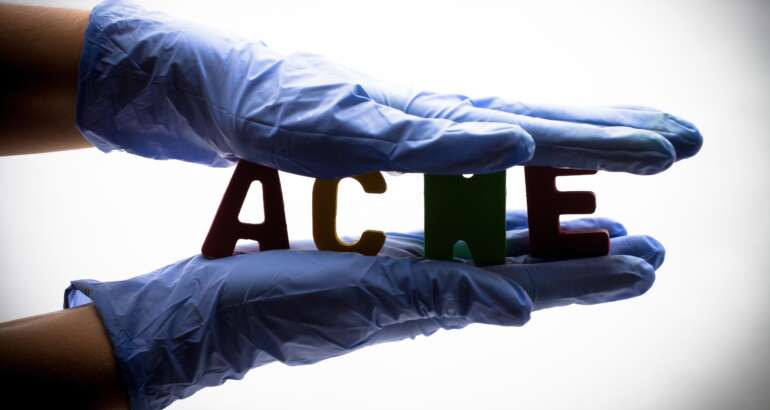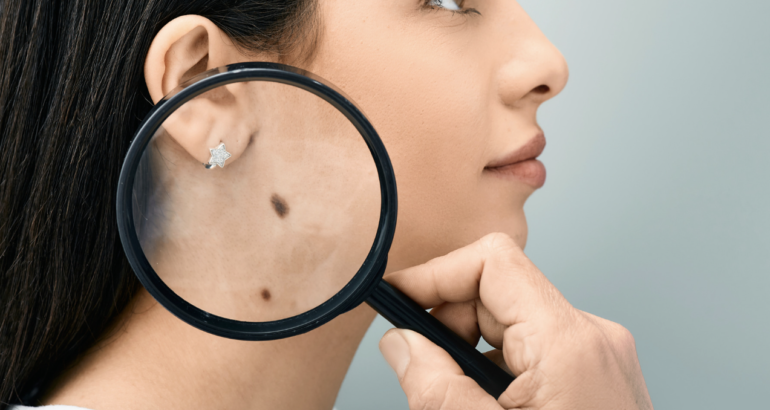Skin cancer is the most common type of cancer there is. But if you know what to look for, you can spot warning signs of skin cancer early and be preemptive in your treatment. Finding it early, when it’s small and has not spread, makes skin cancer that much easier to treat. Keep reading to learn all you need to know about early skin cancer detection from a skin cancer specialist in Georgia.
Some doctors and other health care professionals include skin exams as part of their routine health check-ups. Many doctors also recommend that you check your own skin about once a month. You can use the “ABCDE rule” to look for some of the common signs of melanoma, one of the most common forms of skin cancer:
- Asymmetry: One part of a mole or birthmark doesn’t match the other. Noncancerous moles are typically symmetrical.
- Border: The edges are irregular, ragged, notched, or blurred, or it may be pink or red in color. A typical spot or mole is likely to have well-defined borders.
- Color: The color is not the same all over and may include shades of brown or black, sometimes with patches of pink, red, white, or blue. A typical mole tends to be evenly colored, usually a single shade of brown or black. Amelanotic melanomas are harder to detect. They don’t change melanin, so they’re the same color as your skin. They’re often diagnosed late because of this.
- Diameter: The spot is larger than ¼ inch across – about the size of a pencil eraser – although melanomas can sometimes be smaller than this.
- Evolving: The mole is changing in size, shape, or color. They may also start to itch or bleed. Benign (noncancerous) spots and moles don’t usually change.
Melanoma In Darker Skin
Brown and black melanomas are harder to spot on dark skin. If your skin is dark, it’s important to examine your skin very closely, taking note of these signs: a growth or darker patch of skin that’s growing or changing, a sore that doesn’t heal, or a dark line underneath or around a fingernail or toenail.
Acral lentiginous melanoma tends to be more aggressive and is the most common type of melanoma in people with darker skin. It’s most likely to develop in hard-to-spot places, such as under fingernails and toenails, or sometimes on the palms of your hands and soles of your feet. People with darker skin are at a higher risk of developing a melanoma.
How To Self-Examine
- Examine your front and back in a full-length mirror. Turn and lift your arms to check the sides.
- Bend your elbows to check your underarms, forearms, and palms.
- Sit down to check the backs of your legs and feet, the spaces between your toes, and soles.
- Use a hand mirror to check the back of your neck. Part your hair to check your scalp.
- Use a hand mirror to check your back and buttocks.
- Use a hand mirror to check in your groin area.
Blemishes That Could Be Confused For Cancer
It’s important to remember that not every flaw in the skin is a sign of cancer. Noncancerous skin spots that can look like cancer include:
- Dermatofibromas are small, firm bumps ranging from pink to red to brown in color.
- Keloids are raised growths that develop near wounds and are usually darker than the surrounding skin. They’re typically more common in people with dark skin.
- Moles are dark clusters of pigment-producing cells. They’re usually benign, however these can become cancerous.
- Seborrheic keratoses are round or oval spots that are tan, brown, or black. They may appear in groups. They also tend to appear as you get older, are usually scaly, and look like they can be picked off.
- Skin tags are small flaps of skin that match the color of your skin.
However, you should always double check with your doctor before dismissing something that you might think of as normal!
Basal Cell Carcinomas
Basal cell carcinomas are more common than melanomas, but they are usually much easier to treat. The basal cell carcinomas (BCC) usually grow on parts of the body that get the most sun, such as the face, head, and neck. However, they can still show up anywhere. Normal basal cells line the epidermis.
They’re the skin cells that replace old cells with new ones. Cancer of the basal cells results in tumors that appear on the skin’s surface. These tumors often look like sores, growths, bumps, scars, or red patches. While BCC almost never spreads to other places in the body (metastasizes), it can still result in disfigurement. In rare cases, it can spread to other parts of the body. If it does, it can become life-threatening.
When self-examining for BCC look for flat, firm, pale or yellow areas, similar to a scar. Also, raised reddish patches that might be itchy, small translucent, shiny, pearly bumps that are pink or red and which might have blue, brown, or black areas, pink growths with raised edges and a lower area in their center, which might have abnormal blood vessels spreading out like the spokes of a wheel, or open sores (that may have oozing or crusted areas) and which don’t heal, or heal and then come back.
Squamous Cell Carcinomas
Squamous cell carcinoma is a life-threatening type of skin cancer. The squamous cells are small, flat cells in the outer layer of skin. When these cells become cancerous, they typically develop into rounded skin tumors that can be flat or raised. Sometimes the skin around the tumor gets red and swollen. Squamous cell carcinoma can also occur on the penis or vulva. Squamous cell carcinoma sometimes develops from a precancerous skin growth called an actinic keratosis.
The risk of developing this type of skin cancer is increased among fair-skinned and fair-haired people who have repeatedly been exposed to strong sunlight, individuals who had freckles as a child, and those with blue eyes. Other risk factors include taking immunosuppressants (drugs that weaken the immune system) and being exposed to industrial pollutants such as arsenic, tar, and industrial oils. Squamous cell carcinoma is the second most common type of skin cancer in the United States, after basal cell carcinoma.
When self-examining for squamous cell carcinoma, look for rough or scaly red patches, which might crust or bleed, raised growths or lumps, sometimes with a lower area in the center, open sores (that may have oozing or crusted areas) and which don’t heal, or heal and then come back, and wart-like growths.
Additional Things To Look For
Not all skin cancers are going to match these descriptions. Point out anything you’re concerned about to your doctor, including:
- Any new spots
- Any spot that doesn’t look like others on your body
- Any sore that doesn’t heal or does heal then comes back
- Redness or new swelling beyond the border of a mole
- Color that spreads from the border of a spot into surrounding skin
- Itching, pain, or tenderness in an area that doesn’t go away or goes away then comes back
- Changes in the surface of a mole, including oozing, scaliness, bleeding, or the appearance of a lump or bump
If you have an area of concern, or you just like to be thorough with your health, then Acworth Dermatology and Skin Cancer Center is a great place to turn to.
Johnathan L. Chappell, MD, is a skin cancer specialist who is experienced with diagnosing, examining, and treating precancerous and cancerous lesions, so if you have any concerns then contact Acworth at (678) 505-8030.



